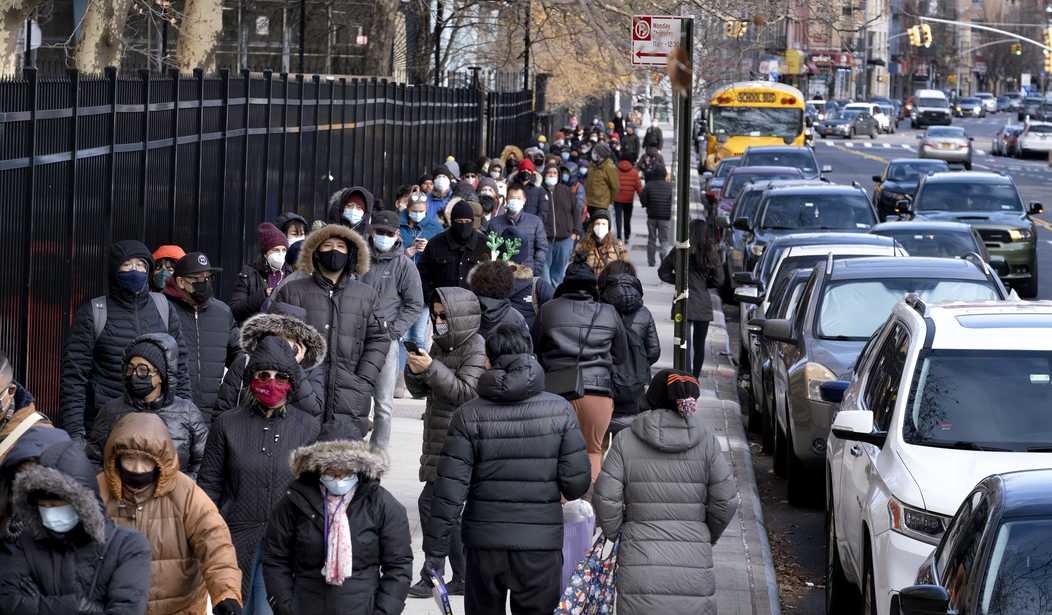“How many people in the hospital with COVID are actually there for COVID?” That’s a key question at this stage of the pandemic. The stratospheric number of cases from Omicron means we’re destined to see a steep rise in hospitalizations too, but scientists in South Africa and the UK have reported that many patients hospitalized for COVID lately don’t have symptoms. They’re being admitted for unrelated reasons and then testing positive incidentally upon intake. Scott Gottlieb estimated recently that 20 percent or so of all COVID hospitalizations during the pandemic have been incidental, but with Omicron that number has gone way up. The variant is so contagious, and in some people so mild, that they don’t realize they have it until hospital staff forces them to check.
When we say the number of incidentals has gone way up, how far up has it gone? England offers a clue:
🚨 NEW | Figures to 4 January show 37% of Covid positive hospital patients in England are not primarily being treated for Covid. pic.twitter.com/mkOXtVdQyn
— Michael Simmons (@Simmons__) January 7, 2022
Other data from the UK confirms that hospitalizations are milder on average — much milder — with Omicron:
The occupation level of ventilation beds in London is probably the most promising Omicron-related chart going. It's been more than two weeks now since London cases peaked. pic.twitter.com/9kzZTXRMOV
— Mike Bird (@Birdyword) January 7, 2022
But what about the U.S.? Specifically, what about America’s hot spot, New York City? According to new data, 51 percent of COVID hospitalizations there are incidental. Statewide it’s 43 percent.
New York has its first official breakdown of what share of people are hospitalized for COVID vs. how many are hospitalized with incidental COVID. In NYC it's 49% for COVID, everyone else just happened to test positive. pic.twitter.com/fNUmMK2DM9
— Alyssa Katz (@alykatzz) January 7, 2022
That explains why daily deaths are no longer closely tracking hospitalizations. As the number of incidentals rises, the divergence between the two metrics widens.
Be careful about assuming that hospital numbers everywhere look like NYC’s, though. It may be that major metropolises like New York and L.A. are seeing higher shares of incidental cases because Omicron spreads like lightning in dense urban areas. In less populated parts of the country, where the variant hasn’t exploded yet, Delta may still be the main bug going around. The New York data above proves the point, in fact, as some parts of the state are seeing less than half as much incidental admission as New York City is. WaPo has been gathering numbers too:
In Los Angeles, where the fast-spreading omicron variant reigns, roughly two-thirds of covid patients in the county’s public hospitals were initially admitted for other causes, officials said Wednesday.
But at CoxHealth in Springfield, Mo., where officials say the older delta variant remains a ferocious threat, the coronavirus remains the immediate cause for 81 percent of covid hospitalizations…
[T]he emerging picture varies dramatically from one region to the next, according to interviews with hospital leaders and health workers across 18 states. It ranges from omicron epicenters such as New York City, where many patients aren’t aware they’re infected until testing positive while visiting the hospital for other procedures, to Michigan and Minnesota, where health workers continue to treat patients fighting for survival against the more severe delta variant.
Doctors describe three types of patients lately — the incidentals who are admitted for unrelated reasons, the people who really are sick from COVID, and a group with underlying conditions whose health has worsened after being infected even though their COVID symptoms are mild. Needless to say, doctors and nurses have to tend to all of them. There may be fewer severe hospitalizations for COVID now, easing strain on ICUs, but the overall patient load is enormous.
When will it get better in NYC? Soon-ish: Scott Gottlieb thinks the city has reached its peak, although he emphasizes that it’s a peak in cases. Hospitalizations always lag, so those will continue to risk for a few more weeks. Watch, then read on.
"Companies that have had their employees back at work and have put in place measures to protect them can continue to do that," says @ScottGottliebMD. "It does appear NY has peaked. DC, Puerto Rico, MD, FL, DE all appear to be turning the corner on their epidemic curve." pic.twitter.com/hrm47Gj0D5
— Squawk Box (@SquawkCNBC) January 7, 2022
Is he right? Looks that way.

The positivity rate, which had been rising at a vertiginous rate, has also now leveled off:
Manhattan continues to trend down as well. In fact, all of New York City has plateaued in 7-day positivity, with two straight days at 22.5%. Queens, Staten Island and the Bronx are just about peaked too. pic.twitter.com/crlCrp1HwS
— Aaron Astor (@AstorAaron) January 6, 2022
Deaths have climbed lately and will continue to climb over the course of this month since they’re another lagging indicator. But this graph puts into perspective how small the current surge is relative to the horrendous spike when COVID first struck the city in March 2020.

The current seven-day average of daily deaths is 48, far less than 10 percent of New York’s worst peak during the first weeks of the pandemic and still way off the pace of last winter, which topped out at 85 per day. I assume NYC will eventually pass that at some point this month but it’ll take many, many more cases to get there this winter than it did last winter. That’s what a full year of immunity building across the population has done to limit severe disease. An amazing graph:
ICNARC have updated their analysis of COVID patients in critical care in England, Wales and NI. They now show boosted patients as well.
They are shown in green.
Yes, I've put them on the chart.
You have to squint. pic.twitter.com/51nVHbxl6s— Paul Mainwood (@PaulMainwood) January 7, 2022
Natural immunity is helping too. A new study from Qatar finds that infection with a previous strain of the virus is only 56 percent effective at preventing symptomatic reinfection by Omicron but it’s 88 percent effective at preventing severe illness caused by the new variant. There’s been a ton of natural immunity in NYC for nearly two years thanks to that awful first wave, which probably explains why their death curve has remained largely flat since spring 2020. How communities with less immunity end up faring against Omicron is another major mystery of the pandemic circa January 2022, one which we’ll have the solution to soon enough.







Join the conversation as a VIP Member